So, how can you learn Cantonese with CantoneseClass101?
This review will give you the overview of CantoneseClass101 — all the facts and features in a straight forward, no B.S. manner so that you can see if this program is for you.
Cool? Cool.
CantoneseClass101 Review Summary:
- Type of program: 100s of audio/video lessons by real teachers and supplementary study tools
- How to learn: Play the lessons, use study tools for extra review
- For who: Beginners and experienced learners (lessons for all levels) of any age
- Learn on: any computer, iPhone, iPad, Android or tablet
- Prices: Free account, and starting from $4/month
- Good for: Learning conversations, listening, speaking Cantonese.
- Time investment: At least 5 minutes a day. Lessons are 3-15 minutes on average.
How CantoneseClass101 Teaches You
The audio and video lessons are the core of CantoneseClass101.
When you sign up, you’ll set your level (Absolute Beginner to Advanced).
Then, they give you a pathway of lessons based on your level. For example, here’s the Absolute Beginner (Level 1) pathway with over 50+ lessons. All for you to follow from 1, to 2, to 3, until you’re done.
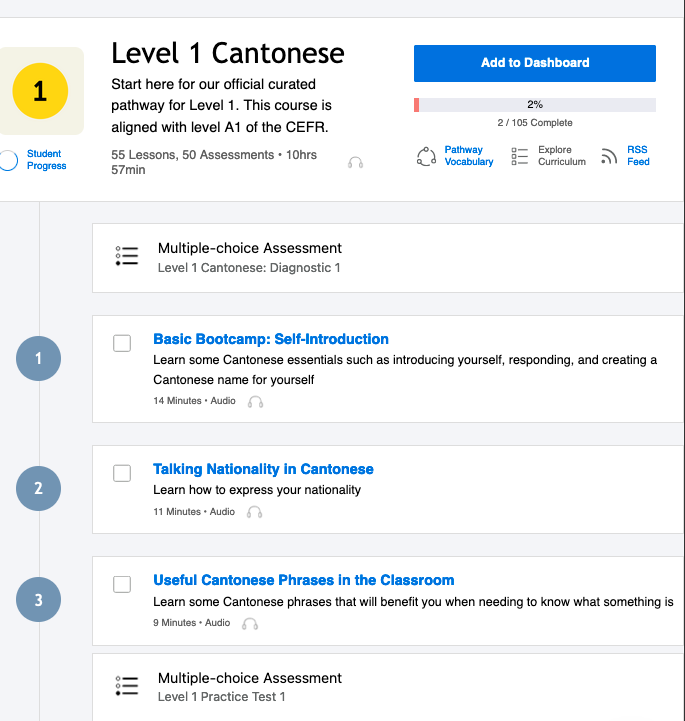
Speaking of the lessons…
Unlike other programs that have you read word lists, play matching games, and do fill-in-the-blanks, with CantoneseClass101 you immediately jump into Cantonese conversations. Meaning, you’re listening (or watching – if a video lesson) to native speakers and teachers speak in Cantonese.
So the first lesson would cover how to introduce yourself in Cantonese.
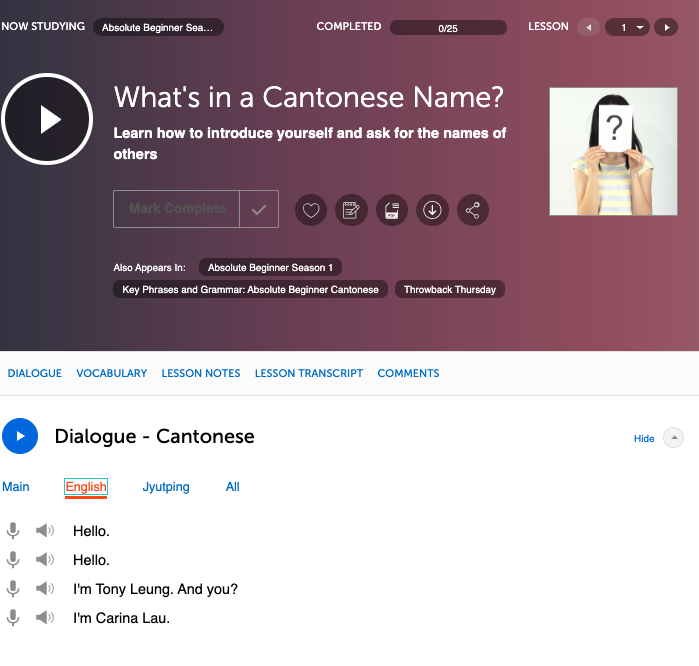
How Do Lessons Work?
You press play, you listen to an audio lesson or watch a video lesson.
The teachers give you a conversation, then again with the translation, and then they explain all the words and grammar rules. Then, you hear the conversation once more at the end. In total, you hear the conversation 3 times.
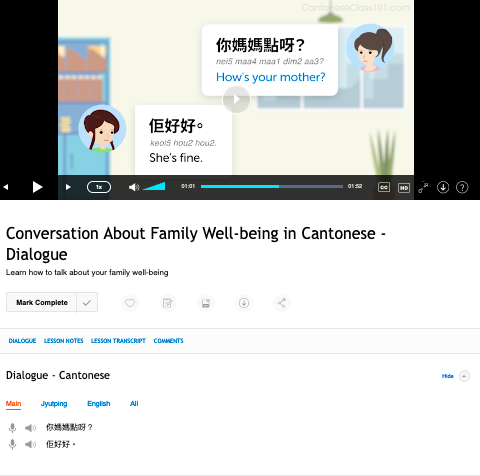
Lessons cover practical dialogues like greetings, shopping, small talk, asking about weather, family, travel and much more.
So, in those 3-15 minutes…
- You learn a simple conversation
- You learn all kinds of vocabulary
- You pick on a grammar rule or two
- And you can start speaking (if you repeat what you hear)
Once you’re done with a lesson, you mark it as complete and then the pathway guides you to the next lesson. But, we’ll talk more about that later.
By the way…
If you want to check it out for yourself, here’s a completely free and unlocked lesson. No registration needed.
https://www.Cantoneseclass101.com/lesson
You Can Follow Along to Learn Faster
Listening to Cantonese conversations is one thing.
And chances are, some words will go over your head.
But, if you have a transcript to follow along with, you won’t miss a word.
So with the lessons, you also get lesson notes and transcripts.
When you follow along with text, you can pick up on every word that’s said and improve your listening.
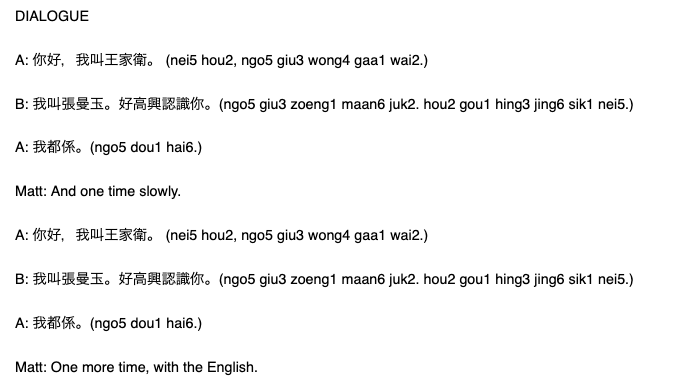
- PDF Lesson Notes: Gives you the conversation and translations, grammar explanations and lesson vocabulary.
- Transcript: The complete transcript of what the teachers say in the lesson.
Personally, I like to look the lesson notes after the lesson just to refresh myself on the dialogue and grammar explanations.
Lesson notes let you review without re-doing the whole lesson, although that’s up to you. Some people like to read it before the lesson in order to “prime” their brain. Some read along — which is also a good idea. Some use it for review. And some likely don’t use the notes at all.
The transcript can also be useful for following along as it is the complete transcript of the lesson — Cantonese and English included. For some people this is useful because you tend to retain more by engaging multiple senses (listening and reading), instead of listening to an audio by itself (or watching a video by itself).
Cantonese Conversations Broken Down
Sometimes, native speakers can speak way too fast for beginners.
And even if they speak slow…
Sometimes, you just can’t pick up on the new words and can’t tell where one ended and another word started.
For that, CantoneseClass101 gives you a line-by-line breakdown of a lesson’s conversation.
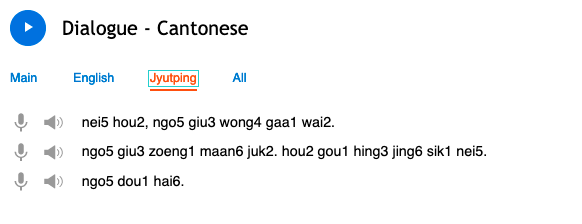
So you can review each line of the conversation… one at a time.
In my opinion, this is one of the most powerful CantoneseClass101 Premium features.
If you can break down and slow down the conversations, you can pick them up quite quickly and learn Cantonese much easier.
How to use the line-by-line Dialogue:
- Listen to the audio of each line one at a time
- Get the translation for each line (click/tap on English)
- Practice saying each line and compare it against native speakers with the voice recording option
- You can also download the Dialogue track, which is just the conversation with no English to review
Review with the Vocabulary Section
Then, there’s the Lesson Vocabulary section.
If you’re done with a lesson and want to review the words, that’s what this list is for.
You can read through the words, listen to the pronunciation, or slow it down (which is nice).
You can also create a Flashcard deck from the words or send words to your WordBank. I found the Flashcard option very useful, and after every lesson, I send the words to my Flashcard deck so I can review them later.
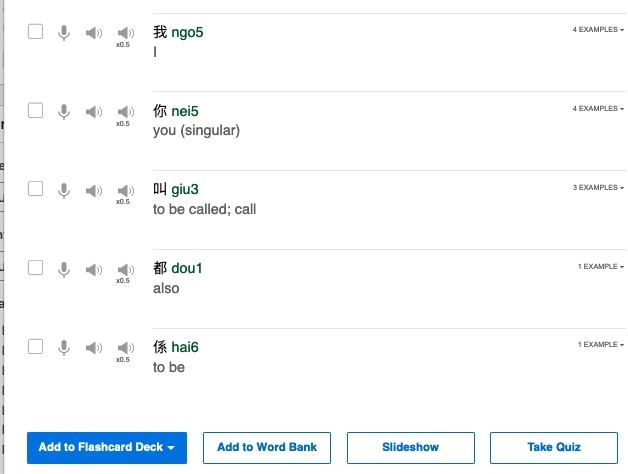
Recap of how to use & features involved:
- Listen to the Audio pronunciation
- Listen to the slowed-down version
- Practice saying each word with the voice recording option
- Review words with the Slideshow
- Review with the Quiz
- Send the words to the 1) Word Bank or 2) Flashcards for further study
CantoneseClass101 Feeds You The Next Lessons
As any structured course would, CantoneseClass101 feeds you the next lessons (down the pathway).
You just have to mark the lesson as complete, and the system will update your progress. You’ll see your progress updated on the Dashboard (which also feeds you your next lessons.)

It’s easy to get lost and overloaded with learning a language since there’s so much to do.
But, the beauty in the Dashboard is that it keeps you on track and keeps the process simple. Done with lesson #1? You get lesson #2. Then #3. And so on.
Click here to visit CantoneseClass101 & sign up for free.
You Get Tested & Practice Your Cantonese
Now, it’s one thing to hear some Cantonese…
Or watch a video lesson… and think you’re good. But you’re not.
Taking in new information is only 1/2 the battle. The second half of the battle is using and practicing the Cantonese that you learn.
So, after every few lessons, CantoneseClass101 gives you “Assessments.” There are Multiple-choice Assessments and Hand-graded Assessments. Assessments test you on the words and grammar rules you’ve learned in the last few lessons.
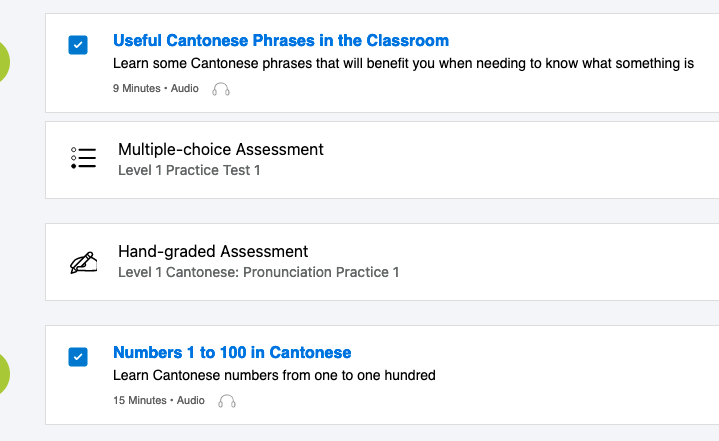
Below is what an assessment exercise would look like.

And the Hand-graded ones test you on speaking and writing… so you get to practice speaking out loud. These ones are graded by real teachers — which is a nice touch.
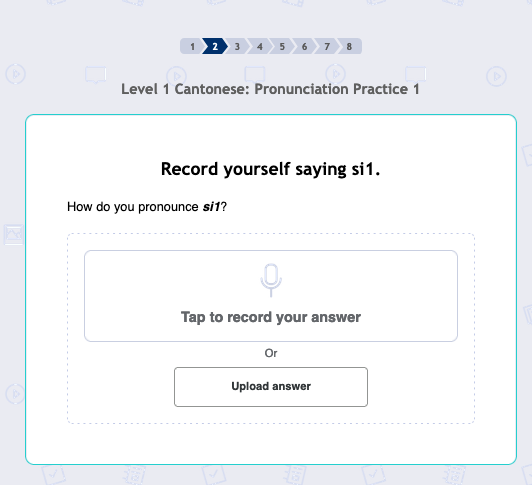
Study Tools & Features Laid Out
So now you know how CantoneseClass101 pretty much works.
Here’s an overview of the study tools they offer.
- Recommended Pathway: Your official starting point and pathway of lessons to take.
- Lesson Library: This is where you’ll find their 100s of lessons and learning paths to take
- 2000 Core Word List (2000 most common Cantonese Words)
- Flashcards to help you learn words
- Word Bank to save words and create study sheets
- Voice Recorder to record yourself and compare with native speakers
- Premium PLUS My Teacher – this gives you an on-site teacher via their Premium PLUS messenger
- Assessments: Test you on the Cantonese you’ve learned every few lessons.
- The Word of the Day Emails (free complementary service): You just get a new word every day.
Conclusion: Is it Worth it?
Now, let’s finish up this CantoneseClass101 review.
Is CantoneseClass101 worth it?
My opinion? I’d say yes. I’m a big fan of learning from conversations. The testing is a nice touch. And they have literally 100s of lessons to expose you to real Cantonese and level you up from beginner to advanced. But, that doesn’t mean that CantoneseClass101 might be useful for everyone.
| Pros | Cons |
|
|
Click here to visit CantoneseClass101 & sign up for free.
Secret Lifetime Premium Membership: Although CantoneseClass101 offers subscriptions, there is a lifetime option if you’re interested. Their Lifetime Premium plan isn’t really advertised much (I found it only during their Holiday sale), but you can check it out here. If you’re a lifelong learner and want to have the Cantonese language with you for life, I recommend checking it out.
- Click here to learn more about CantoneseClass101 Lifetime Premium.
Review written by Linguajunkie.
August 2022.